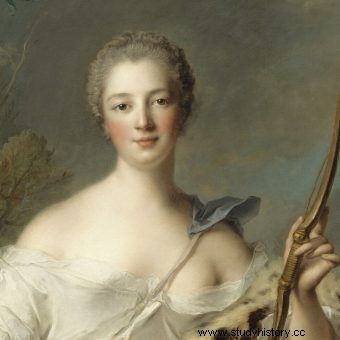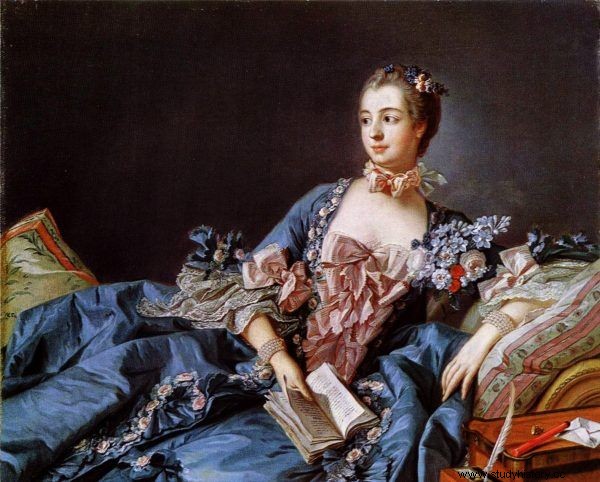Some accuse her of disastrously leading French politics and incapacitating the king. Others praise her excellent taste, beautiful voice and dazzling beauty. One thing is certain:for two decades she has been setting trends, from hairstyles to ... diplomacy. How did the Marquis de Pompadour get this position?
"You will be the king's mistress," the fairy, Madame Lebon, told the young Jeanne Antoinette Poisson. The girl, born in 1721, the future Marquis de Pompadour, was nine years old at the time and probably could not be further from the throne. She came from a middle-class family, her father, convicted of financial embezzlement, was outside France, and her mother traded in leather goods. Jeanne Antoinette, however, remembered the fortune.

Madame de Pompadour as goddess Diana.
At that time, nothing foreshadowed a brilliant career at the French court. Her life was going perfectly normal. She could speak of happiness - thanks to the resourcefulness of her mother, Louise-Madeleine de La Motte, and the support of her protector, the financier Charles Le Normant de Tournehem, she received a careful education.
In 1741, her guardian also provided her with a favorable marriage. He married her to his nephew, Charles-Guillaume Le Normant d'Étiolles. The young couple, who quickly made two children, shared their time between a Paris apartment and their headquarters on the edge of the Sénart Forest. Perhaps it was near the latter that King Louis XV saw the future favorite for the first time?
"Everyone would like her to be a lover"
"The virgin is twenty-three years old, has a dazzling complexion and wonderful gray-green eyes, she is indeed a" royal morsel "and is only waiting for an opportunity to take fate into her own hands" - described the young lady d'Étiolles in the book "The Erotic History of French Diplomacy" by Nicolas Mietton . No wonder she was on the king's radar. The more that this one already missed a new love, because his previous mistress, Madame de Châteauroux, died in December 1744.

A schemer without scruples and morals who incapacitated the king or a beautiful, intelligent woman, a symbol of grace and grace? Which Madame de Pompadour was real?
When exactly Louis XV met Jeanne Antoinette, we do not know. However, the king quickly succumbed to "eyes of fire, wit and flash like no other woman's" - as Count Dufort du Cheverny wrote. "Everyone would like her to be a mistress," added the enchanted aristocrat. The first tryst, according to Mietton, took place in February 1745:
It was rumored that the king and Madame d'Étiolles exchanged kisses for the first time at a costume ball held at the Grande Galleries of the Palace of Versailles on February 25, 1745. The king was said to have been dressed as a yew tree, and she was wearing a long black dress with a hood.
At first, the affair between the monarch and the bourgeoisie caused only mockery at the court. "They are mere courtship and not a mistress," argued Prince de Luynes flatly. Ludwik soon led him out of his mistake. In June, Jeanne broke up with her husband. In the same month, she was also introduced to the Queen with a new title:Marquise de Pompadour .
The Favorite… and so much more
The marquess's first steps outside must have been very uncertain. She did, however, gain guides in a world of courteous complexities:one in particular, Father de Bernis, won her sympathy (and he benefited greatly from it in a short time). A clever and intelligent woman quickly acquired refinement, strengthening her position.
The king found out that he found there not only a charming object of sighs, but also an excellent organizer of cultural life. To tear him apart - and tie him even more! - learned to entertain him . She put on theater performances (even took part in some of them), planned games, invited philosophers and artists to her place.
And although, as the researcher Philippe Hourcade emphasizes, her patronage concerned specific people rather than specific ideas, people of science and art found her a devoted patron. In later years, she consciously posed as a representative of the germinating Enlightenment. This is evidenced by, for example, the portraits of her engrossed in reading or at least surrounded by books.

Madame de Pompadour consciously created her image as "enlightened". That's why she often posed with a book.
The Marquis de Pompadour also retained the position of a royal favorite with which one can spend time pleasantly after her romance with Louis turned into a platonic relationship. It happened around 1750. This is how Mietton describes the situation in The History of French Erotic Diplomacy:
Meanwhile, the royal favorite, suffering from an STD and possibly sexually cold, stops having sex with her lover; but wishing to retain his influence, offers him petites maitresses , irrelevant mistresses who remain at the king's disposal at Parc-aux-Cerfs near Versailles (from French. Park Jeleni - editor's note) . Thanks to this, the marquis tries to avoid an open conflict with a lady who would like to take her place (...)
The existence of the Deer Park was considered a discreet solution, but at the same time "disgusting and indecent". The French imagined that the most promiscuous orgies took place there. Not only was the image of the marquis, still called "the Lady of Fish" (from his maiden name - Poisson, meaning "fish"), but also of the monarch himself, who suffered in this. Jeanne, however, secured a quiet "reign" through this particular policy. From then on, she could not be threatened by any of Louis XV's lovers - including those who had royal descendants!
Maria Teresa's "cousin"
Meanwhile, the royal favorite was also developing political ambitions. The first opportunity to implement them appeared as early as 1746, when the matter of the marriage of the heir to the throne and the eldest son, Louis XV, was being settled. The Marquis supported the candidacy of Maria Józefa Wettyn, promoted by Marshal Maurycy Saski. Queen Maria Leszczyńska, who remembered that it was the Saxons who deprived her father of the Polish throne, opposed the daughter of August III vigorously.
The dolphin's wedding, held in February 1747, was a triumph for Jeanne. Even her fierce enemy, the Duke de Richelieu, admitted it. "Your Majesty, in this case Mme. De Pompadour has served us well "- he told August III when he reached him on a diplomatic mission.
The marquise also had a huge impact on the reversal of French political arrangements, which took place in 1756. In place of the traditional alliance with Prussia, Louis XV concluded a treaty with Austria on April 1 this year at Versailles. His favorite was an ardent advocate of this alliance; together with Fr de Bernis she even helped to negotiate them. As Nicolas Mietton writes:
Austrian Ambassador Kaunitz skillfully convinces her of the friendship Maria Teresa would have for her. Swallowing her pride and forgetting her prejudices, the latter agrees shortly thereafter to write a letter to the marquis, naming her mon amie and has a cousine . Mrs. Fish, Madame Poisson, is delighted, the more so because she hates Frederick II of Prussia, who in his epigrams calls her Cotillion II (...).
Such a situation even for ancien régime she was incredible. "Could we imagine today that Julie Gayet and Cardinal Philippe Barbarin are busy seeking an agreement with Vladimir Putin?" - Mietton asks rhetorically.
"What is left of this woman?"
The undivided "reign" of Madame de Pompadour at the court of Louis XV lasted until her death on April 15, 1765. She breathed her last at Versailles, which was a privilege in itself, as etiquette was not to let anyone else die in the residence except members of the royal family. The monarch, in sickness, visited her every day. He followed her funeral - despite the storm - standing on the terrace.
"What is left of this woman? The Treaty of Versailles, which will last as long as it can, Pigalle's L'Amour sculpture , a painting by Van Loo, and a pinch of gunpowder ”- Denis Diderot wrote shortly after. The eminent philosopher, however, was wrong this time. The figure of the marquess was permanently remembered by posterity. Her image has undergone a significant evolution described by Catherine Thomas:
As early as the 18th century, the Marquis de Pompadour was blamed for all the misfortunes that befell France . People accused her of ruling in place of the king, squandering the kingdom's treasure, shaming the palace (...). This image persisted in 19th-century literature (...). But the historical figure slowly gave way to a graceful symbol, and her name soon evokes a world of pleasure and grace.
“Literally speaking, I still mourn the Marquis de Pompadour; she took the secret of true charm with her to her grave, 'wrote the writer Jules Janin in 1832. Similarly, today hardly anyone remembers the hated "Lady Fish". What are left after the most famous European mistress are hairstyles, porcelain and a characteristic shade of pink.
